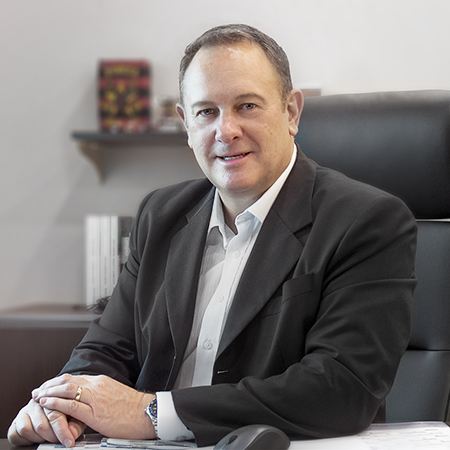January 21, 2019
Set for Growth
Asia’s economy has grown rapidly. China, Southeast Asia, and India are today among the most important economic centers in the world. This is why Pepperl+Fuchs has a strong presence in Asia, too. An interview about the Asian economic growth and Pepperl+Fuchs’ business.

Shanghai or Singapore, Seoul or Tokyo—no matter which Asian metropolis you are in, you can feel the hustle and bustle in the streets. It is not only the large populations, impressive sizes, and giant subway systems that makes these cities pulsating hubs. The economies of China, Southeast Asia, and India have experienced dynamic growth over the past decades.
Shane Parr, Executive Vice President Asia Pacific for the Process Automation Division, has been living in Singapore since 2002. He has great insight into the Asian economy, its growth, and Pepperl+Fuchs´ business there.
Shane ParrIn 1979, Pepperl+Fuchs founded the first non-European subsidiary with its own production facilities in Singapore. This foundation was the first step toward gaining access to the Asian market. Singapore is often called the “gateway to Asia”—not only because of its geographic location. The city-state offers excellent conditions to international companies that want to start business in Asia: political stability, anticorruption measures, and protection of intellectual property, for example.
Shane ParrSince then, Pepperl+Fuchs has expanded its businesses in Asia to many more countries. Some countries have grown significantly, and they continue to do so. Since arriving in 2002, I have seen a change in countries such as China, which developed at such a rapid rate that Pepperl+Fuchs managed to expand our growth, beyond our anticipated levels. Today, we have a strong presence in China and India—for instance, manufacturing facilities in Singapore, Vietnam and Indonesia, and an extensive network of local sales offices throughout Asia. Our Asian headquarters continues to be located in Singapore. In 2016, we opened the Global Distribution Center, which also serves as our logistics hub for direct deliveries to customers throughout Asia. With this investment, we can provide our customers more of our product ranges, delivered on time. Now, more than 1,100 employees work at our two sites in the city-state.
Shane ParrThe largest potential growth markets in the world are currently in Asia, especially China and India. Supporting these markets and continuing to grow our business, with our vast range of products and technologies, can only be effectively done with our own highly trained personnel. This is why we opened three new sales offices in Asia in addition to our existing sites: Kuala Lumpur in Malaysia, Jakarta, Indonesia, joining Taipei in Taiwan. With these new offices, we are able to better support our customers and the growing business opportunities within each of these countries.

Shane ParrAs our products become more complex, we can provide our customers with more in-depth technical knowledge on all our product portfolios, either directly to our end customers or via our distribution networks. More importantly, we can take customer-specific needs directly into our business units more efficiently and clearly enable our company to develop and adapt our product portfolio to suit the local market needs. With the different cultures and languages throughout Asia, it helps to have locally trained personnel dealing within their own cultural boundaries. Our people can also bring forward the Pepperl+Fuchs quality services directly to our customers, providing a major differentiator to our competitors.
Shane ParrWe believe the larger markets like China and India will continue to grow. There is a high innovation potential in Asia, which I am sure will contribute to a positive development. Japan and South Korea have a history in innovation and continue to be innovation leaders in Asia. And there are countries like Singapore, whose government invests in education and promoting innovative projects. The South East Asian markets have significant potential but face more structural and political reform issues, which will be required to fuel significant international investments into these countries.
Shane ParrIndeed, there is a great deal of excitement surrounding IoT, and you might already notice some developments toward Industry 4.0 that are in progress. Process automation business is historically conservative, so we believe that the final move to an IoT platform for controlling a process plant will still take some time. However, there are initial approaches. What we will see are cloud-based data collecting applications to optimize processes. Moreover, we believe the mobile computing and communication devices from our ecom brand are an enabling platform for all these types of IoT implementations.
Shane ParrI am sure that the future is extremely bright in Asia. We are looking forward to seeing investments by our traditional core customers. Of course, we will continue to listen to the market and develop or adapt products specifically required by customers throughout Asia. Our company name is synonymous with technology, quality, on-time delivery, and support. With Industry 4.0 and IoT, Pepperl+Fuchs will be at the forefront of the next industrial revolution, placing us in a good position for the future—not only in Asia.
Economy in Asia
Asia is the fastest growing economic region in the world, with China, Japan, India, South Korea, and Indonesia the top five economies in Asia. Due to their rapid economic development since the 1960s, South Korea, Taiwan, Singapore, and Hong Kong are known as the so called “Four Asian Tigers” or “Four Asian Dragons.” Hong Kong and Singapore are among the biggest financial centers in the world, whereas South Korea and Taiwan are important hubs when it comes to automotive and electronic component manufacturing and information technology. However, economic development widely differs from country to country in Asia.

